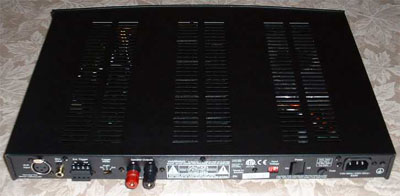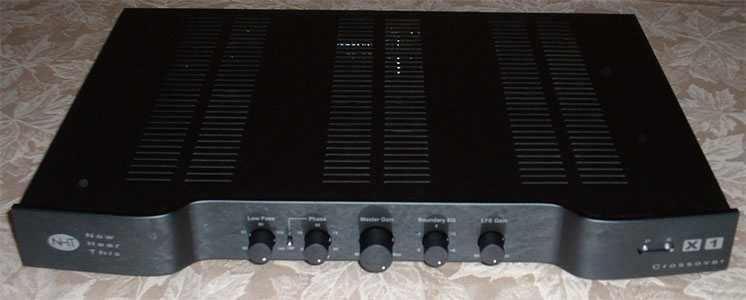|
||||||||||||||||||||||||
|
Introduction The T6 tower speakers are part of NHT's new Evolution product series, which replaces the company's previous product lines, called the Music and Home Theater series. The Evolution line comprises two satellite models and four different configurations of powered subwoofers, including two that form the base of tower speakers when combined with the satellites. The design concept of the speakers in this new line is to provide the end-users with enough flexibility to suit the configuration of their choice in a two-channel or multi-channel system, hence the modular approach. This departs from previous NHT designs, which separate the two applications into two separate product lines. According to NHT, this new concept is driven by the new surround formats such as DVD-A and SACD. The T6 speakers are reviewed here mostly in the context of two-channel applications. However, I did also try them as the main left and right speakers in my home theater system to get an idea as to their capability in such setups. The T6 is the larger of the two tower systems in the Evolution series (the other is T5). They differ only in their capability in producing a particular sound pressure level. The T6 is designed for medium to larger rooms, while the T5 is for small to medium sized rooms.
Although the T5 and T6 are
designated as tower speakers, they are not conventional towers. They are essentially monitors matched with powered subwoofers. In
fact, if your room cannot accommodate tower speakers, you can just match the
monitors with the Evolution standalone subwoofers and get pretty much the
same results. The T6 tower systems arrived in ten separate boxes. That's right, ten boxes! I was surprised when I received so many cartons. Two boxes are for the M6 monitors, two for the B6 subwoofers, one for X1 bass management/active crossover, two for the A1 amplifiers, two for the tower kits, and one for the owner's kit. Then, I remembered that these products are modular by design, so they need to be boxed separately to meet any desired configuration. But, ten boxes for two speakers is a lot of exercise. Hey, maybe that is actually another benefit. If I set up an NHT surround sound system, I can be Schwarzenegger's double in his next movie.
The owner's kit box was marked “Open This First”, so that was
where I started. Inside, I found the owner's manual together with the tools
necessary to assemble the T6 system (Phillips screwdriver and binding post
wrench). The binding post wrench can also function as a bottle opener (nice
little bonus). And that's not all. A pair of black cotton gloves is also
provided so that you won't leave your hand or finger marks on the speaker
cabinets. The M6 monitor is a three-way acoustic suspension speaker, which is magnetically shielded and employs a 1” aluminum dome tweeter, a 4” midrange driver, and a pair of 6.5” woofers. The M6 monitors can be placed horizontally (using it as a center channel for example) or vertically. In the T6 system, however, they are oriented vertically to sit on top of the B6 subwoofers. In such orientation, the tweeters should be positioned inward. The terminal plate on the rear of the monitor sports a pair of gold-plated five-way binding posts and is defaulted for horizontal placement (see photo below). For vertical placement, this terminal plate should be rotated 900 so that the speaker wire can hang straight down nicely. A screwdriver is needed for this terminal rotation. There is also a boundary switch on the terminal plate to adjust the speaker response based on its placement, whether far or near boundaries such as wall or shelf (“0” and “1” position). This switch actually adjusts the monitor's response in the midbass range (80 Hz to 500 Hz). When the switch is in the “1” position (near boundary), the midbass energy is reduced to compensate for the boundary reinforcement.
The B6 subwoofer module (photo below) contains two 12” aluminum cone woofers in an
acoustic suspension design. The two woofers are located on the same side of
the enclosure. The two B6 modules in the T6 package are a mirror image of
each other. The room geometry, speaker placement, as well as other furniture
arrangement in the room determine the B6 modules orientation, that is
whether the woofers facing inwards or outwards.
Also note that while the M6 is magnetically
shielded, the B6 is not. And I can tell you that the magnetic field around
the B6 is quite strong. As I moved the modules to their desired position,
passing in front of my television at about 2 feet away, I noticed
discoloration of its picture. NHT recommends that the modules be placed at
least 18” from the sides of the television. I personally wouldn't feel
comfortable in placing them any closer than about 24” from the television
sides.
The top terminals are for the
M6 monitor, and the bottom terminals are for the B6 subwoofer module.
All the usual subwoofer controls such as a low pass
filter, phase control, and gain control can be found on the front
panel. In addition, there are controls for boundary equalization (front
panel), high pass filter (rear panel) and LFE (Low Frequency Effects) gain.
The X1 can be set to be always on or put in standby. In the standby mode,
the X1 automatically turns on when it detects an audio signal and turn off
after 20 minutes of no signal. Alternatively, it can also be triggered
remotely using a 5-24 volt DC signal. Both balanced (XLR) and unbalanced (RCA)
inputs are provided. It should be noted that the X1 contains special
equalization circuitry that is specifically designed for the Evolution
subwoofers only.
A1 Front Panel
A1 Rear Panel
X1 Rear Panel Both the X1 and A1 have a slim appearance and can easily be rack-mounted using optional hardware. They have the same outer dimensions and can be stacked neatly. If you stack them, the X1 should be placed underneath one of the A1 amplifiers, the reason being that the A1 is equipped with courtesy lamps under the front edge, which illuminate the X1 controls. It could be handy if you need to make adjustments to the X1 controls in the dark.
Although not wide, the T6 speakers are relatively tall and
have a contemporary look. The build-qualities of all the components of the T6
system are excellent. The speaker cabinets are very rigid and heavily
damped, as indicated by raping on their sides. As for the finish, the only
choice is the anthracite matte lacquer finish that NHT currently offers. I did
not dislike the finish, but I just wish that NHT made the high gloss black
version as in its other product line (SuperAudio series). As you can probably tell from my description of the T6 components above, a little bit of effort is required to assemble and set up this system properly. I would recommend browsing through the entire user's manual before initiating the installation, because I think that would help in smoothing out the step-by-step installation and setup procedure. About an hour or two is needed to read the manual and install the T6 system until it produces some sound (not necessarily the “proper” sound though). Then, ongoing adjustments on the controls of the X1 crossover will be needed during the search for the right and best integration of the bass modules for the overall sound. Just consider of all these efforts as the price you have to pay for the flexibility you get. And trust me, the rewards that you are going to have with this system make all these efforts worthwhile! In the manual, NHT provides suggested settings for the X1 controls to use as a starting point. But of course, you need to do more to get the best result. The manual provides a guide for adjusting the bass using familiar music and your subjective judgment. But I would strongly suggest seeking help from an SPL meter and good test tones too for this process. That's what I did for this review. A combination of SPL meter readings and good music will ease the effort a great deal in adjusting the bass. I really admire the control flexibility that the T6 system offers for integration of the bass sound to the overall sound. I was able to get remarkably seamless bass integration and flat response down to about 25 Hz. In fact, the bass response is the flattest I've been able to achieve in my listening room with any speaker systems I've tried. The T6 speakers are not designed to be toed-in. This is because the M6 monitors employ the so-called Focus Image Geometry (FIG) design principle. However, unlike in the company's previous generation line where the FIG principle is manifested physically in the angled front-baffles (classical FIG), in the Evolution line, it is manifested virtually, using the output of the tweeter to cancel that of the midrange at the appropriate angles. The goal is still the same, that is, to reduce the sidewall reflections, which can reduce the quality of the sound. This is done by careful matching of the phase relationship between the tweeter and midrange so as to obtain optimized response at specific range of angles. Jack Hidley, the Director of Engineering at NHT, pointed out that the biggest advantage of virtual FIG over classical FIG is that most customers find squared corner boxes more acceptable. Also, the angled baffles in the classical FIG design made the speakers difficult to place on shelves. Furthermore, the virtual FIG has an advantage to the manufacturer, as the necessity to craft different left and right cabinets is eliminated.
Another thing to note is that the T6 speakers are supposed to
be used with the front cloth grilles on. The manual specifically
mentioned this very point, and that the speakers may sound slightly bright
without the grilles. In life, sometimes you meet people who seem to have everything they want: a terrific spouse, fine home, plenty of money, etc. Those lucky people are a good analogy to my impression of the T6 speakers. They seem to have all the desired attributes of an ideal speaker. Whether it is tonal balance, pace, rhythm, dynamics, image, focus, or you name it, these speakers are excellent. They may not possess the best of each aspect of the performance, but they excel everywhere, and in some cases, can be considered as one of the best. First of all, the T6 speakers have a wonderful tonal balance. Sound in any frequency spectrum (except in the very low end) is presented evenly with high accuracy. I found that, with a good recording, every musical instrument sound was reproduced with proper attack and note decay that created uncanny realism. As such, they induce a high degree of believability, as if the musician is playing the instrument right there in front of me. The combination of an excellent tonal balance with the realistic attack and decay is what I think leads to a beautiful presentation of rhythm and pace. Often, in doing a critical evaluation of these speakers, I was pulled into the music, did some foot-tapping, forgot what I was evaluating, and just enjoyed the music. These speakers often seduced me away from my evaluation of the boxes, with the music they played. Hmm . . . maybe they were just afraid of getting a bad criticism from me. But hey, if the speakers were able to sway me from evaluating, and just dazzled me with their sound, then they had to be good anyway. In fact, not just good, they had to be great in order to do so. In reviewing a product, I usually change the music often and listen just to the parts of the song that I thought would be discriminating, rarely listening to the entire track. But with the T6, often I found myself listening to the whole song instead of just parts of it. That's a testament of how seducing the NHT T6 sound is. The T6 speakers reproduce vocals very naturally and full-bodied. To me, full-body sound characteristics of human vocals are what often differentiate extraordinary speakers and the merely good ones. It adds realism to the overall speaker presentation. Listen for example to Bill Morrissey in the title song from his album "You'll Never Get to Heaven". His voice could sound thin or have too much nasality in the wrong system, but it came out so full and lifelike through the T6 speakers. Also, vocal sibilance produced by the speakers seemed always to be correct and was never edgy. The overall presentation of the T6 speakers is not forward, but is not laid back either. In my system with the T6, the lead singer was just a tad back for most songs, maybe a foot or two behind the plane of the speakers. The portrayal of the soundstage through the T6 speakers is in general deep and wide. The image is steady and could easily extend beyond the left and right speakers. In my notes, I wrote, “These speakers image like crazy”. What I really meant was these speakers create an image effortlessly. Also, the sense of space created by the speakers is tremendous. On music with a lot of instruments playing at once, the sense of separation among instruments is excellent. They never sounded as if they crowded the same space in the soundstage. The T6s are also very dynamic. On loud vs. soft passages, they were able to maintain their resolution and never sounded recessed. They definitely can play very loud without strain. The sound of the cannon blasts in Tschaikovsky's 1812 Overture fromthe Delos test CD was glorious played loudly through the T6. The bass produced by these speakers is deep and tuneful. It's no surprise here, because the T6 system is essentially a set of monitors aided by powered subwoofers. The key is to integrate the monitors with the subwoofer modules correctly, as is the case with any bi-amped system.
I didn't specifically do this review for home theater applications of the T6,
but nevertheless, I tried them that way as an aside. I didn't use them in a
matched system obviously, since I only had the one pair, but from what I heard, I have no doubt that the
T6 would also be great as main speakers in a home theater setup. The nice
thing is that you don't need an additional standalone subwoofer with the T6,
because they already have two powered subwoofers in a pair of T6 speakers! Also, the
X1 crossover provides the capability to mix the LFE output from your
surround processor with the front left and right bass. To say that the NHT Evolution T6 speaker system represents excellence is an understatement. The performance and flexibility offered by these speakers have impressed me, big time. The $4,000 price tag of the T6 system is very reasonable, considering that you get a pair of monitors, two powered subwoofers, and the active crossover that integrates it all. While "best" is relative to one's personal opinion, the combination of its brilliant performance, its flexibility, and its high value could easily put the T6 system on someone's short list. Kudos to NHT, who have came up once again with a very impressive speaker package.
- Yongki
Go -
CD playback: Shanling CD-S100, Yamaha CDC-755, MSB Link DAC
II
|
||||||||||||||||||||||||

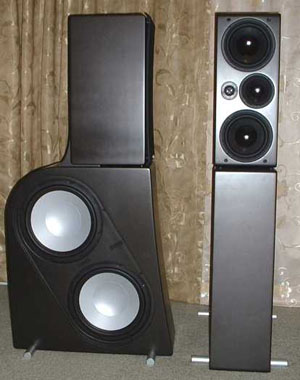

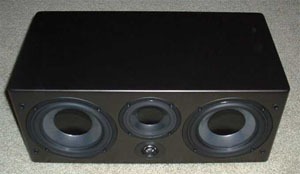
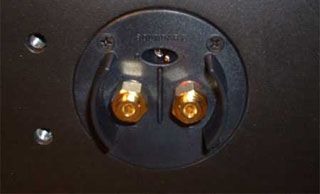
 The modules should be
oriented such that the woofers are as far away from large objects or room
boundaries as possible.
The modules should be
oriented such that the woofers are as far away from large objects or room
boundaries as possible.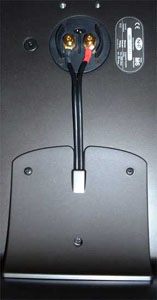 To add
stability to the slim and tall T6 towers, there are two sets of stabilizer bars to be
attached on the bottom of the B6 modules (two bars for each module). Metal spikes are also supplied to further decouple the speakers
from the floor, which could improve their performance. NHT is thoughtful
enough to provide four small metal cups to be placed underneath the spikes so
that the spikes won't damage your wood or tile floors.
To add
stability to the slim and tall T6 towers, there are two sets of stabilizer bars to be
attached on the bottom of the B6 modules (two bars for each module). Metal spikes are also supplied to further decouple the speakers
from the floor, which could improve their performance. NHT is thoughtful
enough to provide four small metal cups to be placed underneath the spikes so
that the spikes won't damage your wood or tile floors. 
